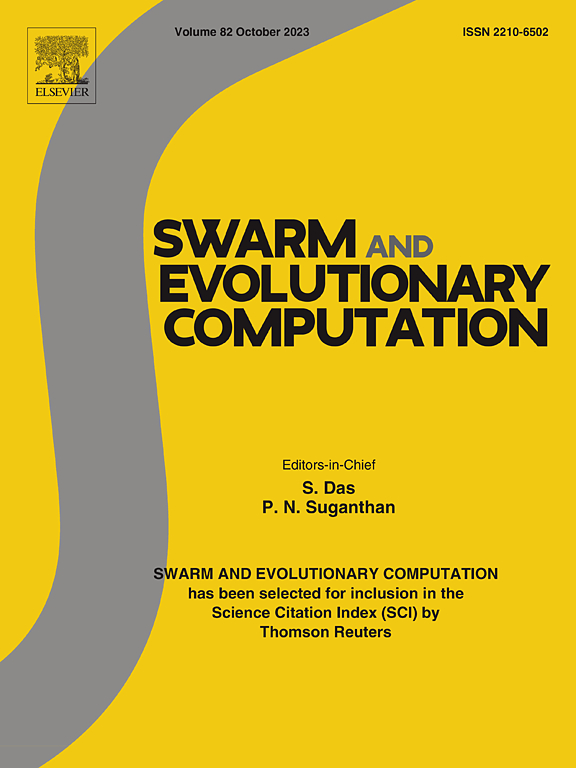通信系统中带通滤波器和波分复用器的性能优化
IF 8.5
1区 计算机科学
Q1 COMPUTER SCIENCE, ARTIFICIAL INTELLIGENCE
引用次数: 0
摘要
在下一代通信系统中,对紧凑、高速和频谱精确的组件的需求不断增长,对光子带通滤波器(bpf)和波分复用器(wdm)的设计和优化提出了重大挑战。传统的算法,如遗传和田口优化(GTO)、粒子群优化(PSO)、Grasshopper优化(GRO)和白头鹰搜索优化(BESO),在应用于复杂的高维光子结构时,往往存在过早收敛、光谱不准确、灵活性有限和可扩展性差的问题。为了解决这些限制,本研究引入了高级分布式动态差分进化(AD3E)算法,这是一种先进的分布式优化技术。应用于一维SiyGe1-y-SiO2光子晶体,AD3E在BPFs中取得了优异的效果。透过率为9814%,中心波长为1550 nm处的FWHM为0.4 nm, wdm为99。透过率为9579%,FWHM为0.4 nm,通道间距为0.6 nm以避免串扰。AD3E的动态参数自适应明显优于静态设置。进一步的验证表明,在±5%的制造公差下,性能下降小于8%,而Wilcoxon符号秩检验(p<0.05)证实了它在32个基准函数(30D和100D)上优于GTO、PSO、GRO和BESO。AD3E作为下一代光子器件优化的强大工具脱颖而出。本文章由计算机程序翻译,如有差异,请以英文原文为准。
Performance optimization of Band Pass Filters and Wavelength Division Multiplexers for communication systems
The growing demand for compact, high-speed, and spectrally precise components in next-generation communication systems poses significant challenges in the design and optimization of photonic Band Pass Filters (BPFs) and Wavelength Division Multiplexers (WDMs). Conventional algorithms, such as Genetic and Taguchi Optimization (GTO), Particle Swarm Optimization (PSO), Grasshopper Optimization (GRO), and Bald Eagle Search Optimization (BESO), often suffer from premature convergence, spectral inaccuracies, limited flexibility, and poor scalability when applied to complex, high-dimensional photonic structures. To address these limitations, this study introduces the Advanced Distributed Dynamic Differential Evolution (AD3E) algorithm, an advanced distributed optimization technique. Applied to 1D SiyGe1-y–SiO2 photonic crystals, AD3E achieves outstanding results in BPFs with 99. 9814% Transmittivity and a 0.4 nm FWHM at the center wavelength of 1550 nm and WDMs with 99. 9579% Transmittivity, a 0.4 nm FWHM and 0.6 nm channel spacing to avoid crosstalk. The dynamic parameter adaptation of AD3E significantly outperforms static settings. Further validation shows less than 8% performance degradation under 5% fabrication tolerance while Wilcoxon signed-rank testing () confirms its statistical superiority over GTO, PSO, GRO, and BESO in 32 benchmark functions (30D and 100D). AD3E stands out as a powerful tool for next-generation photonic device optimization.
求助全文
通过发布文献求助,成功后即可免费获取论文全文。
去求助
来源期刊

Swarm and Evolutionary Computation
COMPUTER SCIENCE, ARTIFICIAL INTELLIGENCEC-COMPUTER SCIENCE, THEORY & METHODS
CiteScore
16.00
自引率
12.00%
发文量
169
期刊介绍:
Swarm and Evolutionary Computation is a pioneering peer-reviewed journal focused on the latest research and advancements in nature-inspired intelligent computation using swarm and evolutionary algorithms. It covers theoretical, experimental, and practical aspects of these paradigms and their hybrids, promoting interdisciplinary research. The journal prioritizes the publication of high-quality, original articles that push the boundaries of evolutionary computation and swarm intelligence. Additionally, it welcomes survey papers on current topics and novel applications. Topics of interest include but are not limited to: Genetic Algorithms, and Genetic Programming, Evolution Strategies, and Evolutionary Programming, Differential Evolution, Artificial Immune Systems, Particle Swarms, Ant Colony, Bacterial Foraging, Artificial Bees, Fireflies Algorithm, Harmony Search, Artificial Life, Digital Organisms, Estimation of Distribution Algorithms, Stochastic Diffusion Search, Quantum Computing, Nano Computing, Membrane Computing, Human-centric Computing, Hybridization of Algorithms, Memetic Computing, Autonomic Computing, Self-organizing systems, Combinatorial, Discrete, Binary, Constrained, Multi-objective, Multi-modal, Dynamic, and Large-scale Optimization.
 求助内容:
求助内容: 应助结果提醒方式:
应助结果提醒方式:


